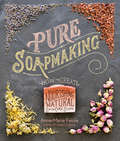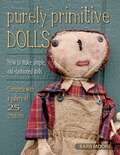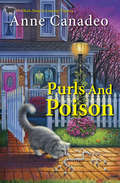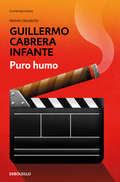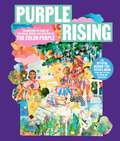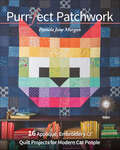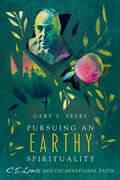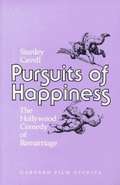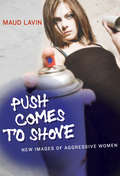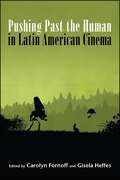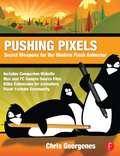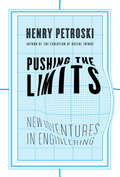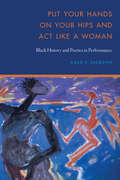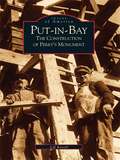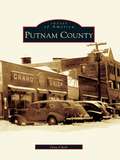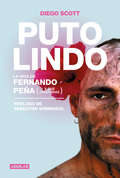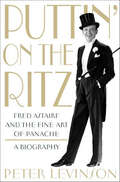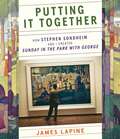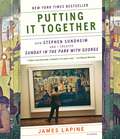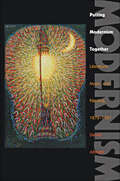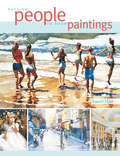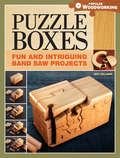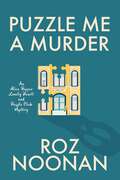- Table View
- List View
Pure Soapmaking: How to Create Nourishing, Natural Skin Care Soaps
by Anne-Marie FaiolaThe pure luxury of soaps made with coconut butter, almond oil, aloe vera, oatmeal, and green tea is one of life&’s little pleasures. And with the help of Anne-Marie Faiola, author of Soap Crafting and Milk Soaps, it&’s easy to make luscious, all-natural soaps right in your own kitchen. This collection of 32 recipes ranges from simple castile bars to intricate swirls, embeds, and marbled and layered looks. Begin with a combination of skin-nourishing oils and then add blueberry puree, dandelion-infused water, almond milk, coffee grounds, mango and avocado butters, black tea, or other delicious ingredients — and then scent your soap with pure essential oils. Step-by-step photography guides you through every stage of cold-process soapmaking.
Pure Wool
by Susan BlackerHow to select and wisely use single-breed wool yarn for knitting, crocheting, and other needlecrafts.
Purely Primitive Dolls
by Barb MooreCreate one-of-a-kind dolls in a primitive folk-art style for unique gifts and home décor. These primitive weathered and worn character dolls will inspire you to make your own.
Purls and Poison (A Black Sheep & Co. Mystery #2)
by Anne Canadeo&“Charming . . . Relatable characters and amusing commentary show why Canadeo is so popular with cozy readers.&” —Publishers Weekly When a fellow Black Sheep Knitter is suspected of poisoning her coworker, the group puts down their needles and takes up their friend&’s defense . . . Suzanne Cavanaugh has just about had it with her office rival at Prestige Properties. It&’s bad enough that Liza Devereaux is constantly needling her at work, but when she shows up at one of Suzanne&’s open houses to poach potential buyers, it&’s the last straw. No one in the office fails to hear the two snarling at each other. When Liza is later found dead in her office cubicle—poisoned by a diet shake—Suzanne becomes the prime suspect. The Black Sheep Knitters have no doubt their friend has been framed—but they need to prove it. Stirred to action, they get together to catch a sneaky killer who&’s trying to pull the wool over everyone&’s eyes . . . &“Members of the Black Sheep knitting group must use their sleuthing talents to rescue one of their own . . . The wrenching ordeal of a Black Sheep as a murder suspect makes this entry the strongest in Canadeo&’s series.&” —Kirkus Reviews
Puro humo
by Guillermo Cabrera InfanteUna rapsodia al acto de fumar y una crónica erudita sobre la relación entre el puro y el cine, con el característico humor de Guillermo Cabrera Infante. Según Guillermo Cabrera Infante, «Puro humo es varios libros a la vez: una historia del tabaco que empieza con su descubrimiento en 1492 por un marino de la nao capitana, Rodrigo de Jerez [...], una celebración del tabaco y del fumar esa hoja extraña, y una rapsodia en que intervienen el cigarrillo y la pipa. Pero es más que nada una crónica erudita de la relación entre el puro y el cine». Cabe añadir que se trata de uno de los mejores ejemplos de la versatilidad de Cabrera Infante, que publicó el libro originalmente en 1985 en inglés después de pasar media vida en Londres, donde utilizaba ese idioma como guionista, articulista y crítico literario. Pospuesta un tiempo, la versión española acabó siendo, no una traducción al uso, sino una reescritura en toda regla que conserva la inventiva y frescura del original. La crítica ha dicho:«Guillermo Cabrera Infante era un grandísimo escritor.»Mario Vargas Llosa «Uno de los mayores y mejores renovadores de la prosa en castellano, un clásico de vanguardia.»Fernando Savater «Su talento verbal era extraordinario, tanto de viva voz como por escrito, aunque esto último lo sepa cualquiera que haya leído sus libros.»Javier Marías «Cabrera Infante trajo al sector desarraigado a la fuerza de Cuba las virtudes de la parodia, la sátira y el humor.»José Miguel Oviedo, Letras Libres
Purple Rising: Celebrating 40 Years of the Magic, Power, and Artistry of The Color Purple
by Lise Funderburg Scott SandersOne of Oprah&’s Favorite Things of 2023 Celebrate the 40th anniversary of the Pulitzer Prize–winning masterpiece The Color Purple—as well as the acclaimed 1985 film from Steven Spielberg, the Tony-winning Broadway musical, and the all-new film adaptation with this gorgeously designed exploration of the novel&’s enduring legacy, featuring contributions from Alice Walker, Oprah Winfrey, Steven Spielberg, Colman Domingo, Fantasia Barrino, Danny Glover, and more. Since its publication in 1982, The Color Purple has resonated with generations of readers across the globe. The novel catapulted author Alice Walker to international fame, brought Oprah Winfrey and Whoopi Goldberg acting acclaim in the 1985 film adaptation, and inspired theatrical productions around the world, including the Tony Award–winning Broadway musical. This cultural touchstone—which so profoundly touches on race, family, survival, spirituality, sisterhood, and love in all forms—continues to beget new iterations, most recently a feature film. Now, an in-depth exploration celebrates The Color Purple&’s ever-expanding legacy as never before: Purple Rising features oral histories and fresh anecdotes based on more than fifty original interviews, as well as vibrant, never-before-seen images. It reveals the crucial real-life experiences that inspired the novel, and the transcendent humanity of its themes that continue to connect with audiences, each new adaptation speaking to the changing times and cultural contexts. Creators, actors, producers, activists, cultural critics, and well-known fans comment on the power of Walker&’s story and how it has affected their lives and artistic choices, including Whoopi Goldberg, Taraji P. Henson, Danielle Brooks, Halle Bailey, Blitz Bazawule, Jon Batiste, H.E.R., Salamishah Tillet, Ricky Dillard, Gabrielle Union, and many more. An insightful and vivid celebration of an enduring classic, Purple Rising is the ultimate gift for fans of all ages and a true celebration of Black joy, storytelling, and achievement.
Purr-fect Patchwork: 16 Appliqué, Embroidery & Quilt Projects for Modern Cat People
by Pamela Jane MorganCat-loving quilters mew-nite! Embrace your inner cat lady with contemporary cat-themed projects! Play with texture and style to create 16 unique projects from bags and decor to 7 different patchwork quilts. Each project includes step-by-step instructions guiding stitchers on a variety of techniques from foundation paper piecing to free-motion embroidery. Also learn how to play with different substrates such as cotton, linen, wool, wool-blended felt, denim, vinyl, and repurposed clothing. From beginners to more experienced, there is something new to learn for every stitcher. The paw-sibilities are endless! Make the most of your feline fabrics and craft 16 original cat-themed quilts and textile projects Use dozens of techniques from basic piecing, hand embroidery, and machine sewing for a vintage-meets-modern aesthetic Experiment with different textiles and fabrics to create bags, accessories, home decor, and quilts
Pursuing an Earthy Spirituality: C. S. Lewis and Incarnational Faith
by Gary S. Selby"Red beef and strong beer" was how C. S. Lewis described his education under one of his early tutors. It was, in other words, a substantial education that engaged deeply with the intellectual tradition and challenged him to grow. Gary Selby sees Lewis's expression as an indication of the kind of transformation that is both possible and necessary for the Christian faith, and he contends that spiritual formation comes about not by retreating from the physical world but through deeper engagement with it. By considering themes such as our human embodiment, our sense of awareness in our everyday experiences, and the role of our human agency—all while engaging with the writings of Lewis, who himself enjoyed food, drink, laughter, and good conversation—Selby demonstrates that an earthy spirituality can be a robust spirituality.
Pursuits of Happiness: The Hollywood Comedy of Remarriage
by Stanley CavellDuring the 30's and 40's, Hollywood produced a genre of madcap comedies that emphasized reuniting the central couple after divorce or separation. And the female protagonists were strong, independent, and sophisticated. Here, Stanley Cavell examines seven of those classic movies for their cinematic techniques, and for such varied themes as feminism, liberty and interdependence. Included are Adam's Rib, Bringing Up Baby, and The Philadelphia Story.
Push Comes to Shove: New Images of Aggressive Women
by Maud LavinThe new celebration of women's aggression in contemporary culture, from Kill Bill and Prime Suspect to the artists group Toxic Titties.In the past, more often than not, aggressive women have been rebuked, told to keep a lid on, turn the other cheek, get over it. Repression more than aggression was seen as woman's domain. But recently there's been a noticeable cultural shift. With growing frequency, women's aggression is now celebrated in contemporary culture—in movies and TV, online ventures, and art. In Push Comes to Shove, Maud Lavin examines these new images of aggressive women and how they affect women's lives.Aggression, says Lavin, need not entail causing harm to another; we can think of it as the use of force to create change—fruitful, destructive, or both. And over the past twenty years, contemporary culture has shown women seizing this power. Lavin chooses provocative examples to explore the complexity of aggression, including the surfer girls in Blue Crush, Helen Mirren as Jane Tennison in Prime Suspect, the homicidal women in Kill Bill, and artist Marlene McCarty's mural-sized Murder Girls.Women need aggression and need to use it consciously, Lavin writes. With Push Comes to Shove, she explores the crucial questions of how to manifest aggression, how to represent it, and how to keep open a cultural space for it.
Pushing Past the Human in Latin American Cinema (SUNY series in Latin American Cinema)
by Carolyn Fornoff; Gisela HeffesPushing Past the Human in Latin American Cinema brings together fourteen scholars to analyze Latin American cinema in dialogue with recent theories of posthumanism and ecocriticism. Together they grapple with how Latin American filmmakers have attempted to "push past the human," and destabilize the myth of anthropocentric exceptionalism that has historically been privileged by cinema and has led to the current climate crisis. While some chapters question the very nature of this enterprise—whether cinema should or even could actualize such a maneuver beyond the human—others signal the ways in which the category of the "human" itself is interrogated by Latin American cinema, revealed to be a fiction that excludes more than it unifies. This volume explores how the moving image reinforces or contests the division between human and nonhuman, and troubles the settler epistemic partition of culture and nature that is at the core of the climate crisis. As the first volume to specifically address how such questions are staged by Latin American cinema, this book brings together analysis of films that respond to environmental degradation, as well as those that articulate a posthumanist ethos that blurs the line between species.
Pushing Pixels: Chris Georgenes’ Secret Weapons for the Modern Flash Animator
by Chris GeorgenesYou've got the cheats, tutorials, and how-tos. What else do you need? Go above and beyond those stop-gaps and step-by-steps with Pushing Pixels, the real-world guide to developing dynamic and fun content from conception to deployment. Whether you are animating for a short, a fun cartoon, or a mobile game, renowned Flash expert Chris Georgenes will show you his approach with various types of animation projects, from start to finish. Providing in-depth knowledge of the little-known secrets used by the pros to produce creative, professional animations, this is the go-to source for anyone looking to create great animation.
Pushing the Limits: New Adventures in Engineering
by Henry PetroskiHere are two dozen tales in the grand adventure of engineering from the Henry Petroski, who has been called America's poet laureate of technology. Pushing the Limits celebrates some of the largest things we have created-bridges, dams, buildings--and provides a startling new vision of engineering's past, its present, and its future. Along the way it highlights our greatest successes, like London's Tower Bridge; our most ambitious projects, like China's Three Gorges Dam; our most embarrassing moments, like the wobbly Millennium Bridge in London; and our greatest failures, like the collapse of the twin towers on September 11. Throughout, Petroski provides fascinating and provocative insights into the world of technology with his trademark erudition and enthusiasm for the subject.
Put Your Hands on Your Hips and Act Like a Woman: Black History and Poetics in Performance
by Gale P. JacksonIn a gathering of griot traditions fusing storytelling, cultural history, and social and literary criticism, Put Your Hands on Your Hips and Act Like a Woman &“re-members&” and represents how women of the African diaspora have drawn on ancient traditions to record memory, history, and experience in performance. These women&’s songs and dances provide us with a wealth of polyphonic text that records their reflections on identity, imagination, and agency, providing a collective performed autobiography that complements the small body of pre-twentieth-century African and African American women&’s writing. Gale P. Jackson engages with a range of vibrant traditions to provide windows into multiple discourses as well as &“new&” and old paradigms for locating the history, philosophy, pedagogy, and theory embedded in a lineage of African diaspora performance and to articulate and address the postcolonial fragmentation of humanist thinking. In lyrically interdisciplinary movement, across herstories, geographies, and genres, cultural continuities, improvisation, and transformative action, Put Your Hands on Your Hips and Act Like a Woman offers a fresh perspective on familiar material and an expansion of our sources, reading, and vision of African diaspora, African American, and American literatures.
Put Your Stamp on It
by Meagan LewisStationery lovers, paper crafters, hand-printing enthusiasts and anyone looking to make personalized gifts will love the simple, colorful projects found in Put Your Stamp On It. Irresistibly cheerful, this book offers step-by-step instructions for hand-stamped gift wrap, tea towels, totes, aprons, and even hair accessories made with reverse printing, layering, borders, and more! Charming illustrations and vibrant photography inspire an endless variety of stamped creations. Best of all, the book includes directions for carving handmade rubber stamps to print on wood, fabric, and paper for a truly personal touch. So go ahead--put your stamp on it!
Put-In-Bay: The Construction of Perry's Monument (Images of America)
by Jeff Kissell"We have met the enemy and they are ours. . . ." So wrote Commodore Oliver Hazard Perry to General William Henry Harrison following his decisive victory over a British fleet at the Battle of Lake Erie. Perry's victory served as a catalyst both for this battle and for ending hostilities in the Old Northwest Theater of the War of 1812. Captured here in over 200 vintage images from the Monument archives, is a pictorial and technical record of how a monument befitting this naval victory and the resulting peace became a reality.During the remainder of his life, the country heralded Perry as a national hero whose bravery and fortitude enabled the U.S. to win, or gain an honorable peace from, its war with England. A deserving result of this victory was creation of a monument to honor Perry and his men. The story of the construction of the monument is as thrilling as the bravery that inspired it-seen here are the original photographs taken by prominent Put-in-Bay photographer G. Otto Herbster, capturing the builders, architects, mishaps, and triumphs that occurred during the construction of one of Ohio's most revered treasures.
Putnam County
by Guy CheliPutnam County, located fifty miles north of New York City and one hundred miles south of Albany, was an important site during the American Revolution and the Civil War. With the advent of the railroad, the county became an important hub for travelers heading to Boston and points north. By the mid-1800s, thousands of workers immigrated here to undertake the enormous task of building dams and reservoirs for New York City's drinking water. A popular vacation destination of past decades, Putnam County today retains much of its original charm and rural flavor.
Puto lindo: La vida de Fernando Peña (y sus criaturas)
by Diego ScottDiego Scott, productor y testigo privilegiado, reconstruye la vida de Fernando Peña y propone recordar a un tipo con un talento descomunal que rompió las estructuras de la radio, el teatro y la televisión de la mano de La Mega, Palito, Roberto Flores, Sabino, Dick Alfredo, Milagritos y Martín Revoira Lynch. A través de la memoria de sus amigos y colaboradores, Diego Scott, productor y testigo privilegiado, reconstruye la vida de Fernando Peña y sus entrañables e inolvidables criaturas. Nos propone recordar a un tipo con una capacidad de observación descomunal que le permitió desarrollar su inmenso talento. Los excesos, la generosidad, la droga, el sexo y la inteligencia fueron solo la punta del iceberg de una personalidad absolutamente sensible que cambió y rompió con todos los formatos de la radio, el teatro y la televisión de la mano de La Mega, Palito, Roberto Flores, Sabino, Dick Alfredo, Milagritos y Martín Revoira Lynch. Como dice Sebastián Wainraich en el prólogo, este libro permite "visitar a Fernando Peña. Sentirlo vivo de nuevo. Traerlo un rato de la muerte para recordarnos que Fernando fue real y que todo lo que pasó y nos pasó con él fue de verdad". Lleno de nostalgia, el libro pone en primer plano nuevamente la voz de Peña y la intimidad de sus últimos días por esta vida que no le resultó fácil: "La gente gay tiene que actuar mucho. Es muy difícil: tu madre te rechaza, tu padre te hace problema, la sociedad, los amigos... entonces tenés que actuar de varias cosas".
Puttin' On the Ritz: Fred Astaire and the Fine Art of Panache, A Biography
by Peter LevinsonFred Astaire defined elegance on the dance floor. With white tie, tails and a succession of elegant partners - Ginger Rogers, Cyd Charisse, Rita Hayworth, Eleanor Powell, Judy Garland and others - he created an indelible image of the Anglo bon vivant. His origins, though, were far more humble: Born in Omaha, Nebraska, Fred Astaire came from Midwestern stock that partially had its origin in the late nineteenth century Jewish communities of Austria. At first, he played second fiddle in vaudeville to his sister, Adele; however, once he learned how to tap and bought his first Brooks Brothers suit, the game changed. How did he transform himself from a small town Nebraska boy into the most sophisticated man ever to dance across a dance floor? In this comprehensive new book about the life and artistry of Fred Astaire, Peter Levinson looks carefully at the entirety of Astaire's career from vaudeville to Broadway to Hollywood to television. He explores Astaire's relationships with his vivacious dance partners, his friendship with songwriters like George Gershwin and Irving Berlin and his relationship with choreographers like Hermes Pan to discover how Astaire, in effect, created his elegant persona. Astaire put his mark on the Hollywood musical, starting his career at RKO and then moving to MGM. From his long list of films, certain classics like "Swing Time", "Top Hat", "Royal Wedding" and "The Bandwagon" revolutionized the presentation of dance on film; but, he also revolutionized the television variety special with the Emmy-Award-Winning "An Evening With Fred Astaire". For 'Puttin' on the Ritz", veteran Hollywood insider, Peter Levinson interviewed over two hundred people who worked closely with Astaire such as Debbie Reynolds, Dick Van Dyke, Artie Shaw, Bobby Short, Oscar Peterson, Mel Ferrer, Betty Garrett, Joel Grey, Arlene Dahl, Michael Kidd, Betty Comden, Onna White, Margaret Whiting, Andy Williams, and others like Quincy Jones, John Travolta, and John Williams, to provide an intimate window on to his professional as well as his personal life. His new biography of Astaire is a celebration of the great era of sophistication on Broadway and in Hollywood as seen through the life of a man who learned how to put on the Ritz and become America's premiere song-and-dance-man: Fred Astaire.
Putting It Together: How Stephen Sondheim And I Created Sunday In The Park With George
by James LapinePutting It Together chronicles the two-year odyssey of creating the iconic Broadway musical Sunday in the Park with George. In 1982, James Lapine, at the beginning of his career as a playwright and director, met Stephen Sondheim, nineteen years his senior and already a legendary Broadway composer and lyricist. Shortly thereafter, the two decided to write a musical inspired by Georges Seurat’s nineteenth-century painting A Sunday Afternoon on the Island of La Grande Jatte. Through conversations between Lapine and Sondheim, as well as most of the production team, and with a treasure trove of personal photographs, sketches, script notes, and sheet music, the two Broadway icons lift the curtain on their beloved musical. Putting It Together is a deeply personal remembrance of their collaboration and friendship and the highs and lows of that journey, one that resulted in the beloved Pulitzer Prize-winning classic.
Putting It Together: How Stephen Sondheim and I Created "Sunday in the Park with George"
by James LapineA NEW YORK TIMES BESTSELLERA behind-the-scenes look at the making of the iconic musical Sunday in the Park with GeorgePutting It Together chronicles the two-year odyssey of creating the iconic Broadway musical Sunday in the Park with George. In 1982, James Lapine, at the beginning of his career as a playwright and director, met Stephen Sondheim, nineteen years his senior and already a legendary Broadway composer and lyricist. Shortly thereafter, the two decided to write a musical inspired by Georges Seurat’s nineteenth-century painting A Sunday Afternoon on the Island of La Grande Jatte. Through conversations between Lapine and Sondheim, as well as most of the production team, and with a treasure trove of personal photographs, sketches, script notes, and sheet music, the two Broadway icons lift the curtain on their beloved musical. Putting It Together is a deeply personal remembrance of their collaboration and friend - ship and the highs and lows of that journey, one that resulted in the beloved Pulitzer Prize–winning classic.
Putting Modernism Together: Literature, Music, and Painting, 1872–1927 (Hopkins Studies in Modernism)
by Daniel AlbrightA powerful introduction to modernism and the creative arts it inspired.How do you rationally connect the diverse literature, music, and painting of an age? Throughout the modernist era—which began roughly in 1872 with the Franco-Prussian War, climaxed with the Great War, and ended with a third catastrophe, the Great Depression—there was a special belligerence to this question. It was a cultural period that envisioned many different models of itself: to the Cubists, it looked like a vast jigsaw puzzle; to the Expressionists, it resembled a convulsive body; to the Dadaists, it brought to mind a heap of junk following an explosion. In Putting Modernism Together, Daniel Albright searches for the center of the modernist movement by assessing these various artistic models, exploring how they generated a stunning range of creative work that was nonetheless wound together aesthetically, and sorting out the cultural assumptions that made each philosophical system attractive. Emerging from Albright's lectures for a popular Harvard University course of the same name, the book investigates different methodologies for comparing the evolution and congruence of artistic movements by studying simultaneous developments that occurred during particularly key modernist years. What does it mean, Albright asks, that Joseph Conrad's Heart of Darkness, published in 1899, appeared at the same time as Claude Debussy's Nocturnes—beyond the fact that the word "Impressionist" has been used to describe each work? Why, in 1912, did the composer Arnold Schoenberg and the painter Vassily Kandinsky feel such striking artistic kinship? And how can we make sense of a movement, fragmented by isms, that looked for value in all sorts of under- or ill-valued places, including evil (Baudelaire), dung heaps (Chekhov), noise (Russolo), obscenity (Lawrence), and triviality (Satie)? Throughout Putting Modernism Together, Albright argues that human culture can best be understood as a growth-pattern or ramifying of artistic, intellectual, and political action. Going beyond merely explaining how the artists in these genres achieved their peculiar effects, he presents challenging new analyses of telling craft details which help students and scholars come to know more fully this bold age of aesthetic extremism.
Putting People in Your Paintings
by Laurel HartCapture the essence of people in your paintingsAdd a personal touch to you watercolors with 11 step-by-step demonstrations that cover people in a variety of scenes and situations. Award-winning artist, Laurel Hart, gives you the techniques you need to capture the living, breathing essence of people. Inside you'll find:Tips for seeing the basic shapes of your subject using lighting and shading techniquesEasy methods for successful design and compositionTechniques for translating photographs into compelling, beautiful paintingsComplete instruction for placing people in settings including cityscapes, landscapes and interiorsLaurel guides you through the process with practical tips, chapter summaries and motivational "Hart-felt insights" that will inspire you to see the beauty of your subject and transfer your emotional response to watercolor. Putting People in Your Paintings gives you all the tools you need to make your paintings come alive!
Puzzle Boxes: Fun and Intriguing Bandsaw Projects
by Jeff VollmerUnlocking the Secrets of the Puzzle Box Have you ever thought inside the box? These band-sawn boxes could be the most intriguing and fun projects you've ever made. Author Jeff Vollmer describes his boxes as key-and-slide–cut a dovetail key, cut a slider piece, cut another key, cut another slider. That's the puzzle or "combination" you use to get to the chamber or heart of the box. Then you cut out the guts of the box to create a chamber. But wait, there's more! Then you cut another box from the guts, then another box or drawer from those pieces, then another and maybe another until things get too small to handle safely. Any type wood can be used to make these boxes–wood with holes, cracks, splits, insect and wormholes, spalting and burls. Jeff calls these flaws "opportunities" to become creative. Please note that the digital version of this book does not include the accompanying DVD.
Puzzle Me a Murder (An Alice Pepper Lonely Hearts and Puzzle Club Mystery)
by Roz NoonanLibrarian Alice Pepper always had a natural talent for figuring out people and puzzles in the small Oregon town of West Hazel. But as a mystery permeates the quiet Pacific Northwestern community, murder is a challenge she&’s not prepared to solve . . . Down-on-her-luck Alice had hoped to retire before turning sixty-five, not struggle to keep her cozy home and dependable job. But even after divorce leaves her golden years a mess, the pieces always come together with a little help from her friends—a fun-loving crew who thrive on jigsaws over coffee, cocktails, and gossip. So, when it&’s time to defend close confidant Ruby Milliner, she springs into action. Only, in this case, supporting Ruby means proving she didn&’t murder her cheating husband! Ruby never wanted to kill George, although anger can make a person say questionable—and incriminating—things. And scheming, deceitful George made a lot of people angry. Alice, fiercely committed to cracking the crime, dives into a secret search to exonerate Ruby. But slimming down a massive suspect list and restoring peace to West Hazel is a real gamble. Because if successful, Alice will meet a vengeful killer whose game she doesn&’t yet know how to play.
